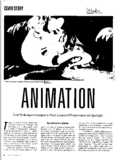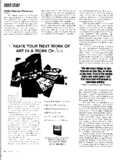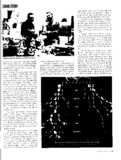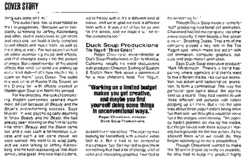



Today, animation means more than hand-painting cels. Though that technique is still widely used in any number of applications, computer graphics have come on strong in recent years, while methods such as stop-motion and the use of cut-outs grow increasingly popular. In fact, Klasky Csupo, the company behind Nickelodeon's hit series "Rugrats," only produces special-edition cels for collectors; the show's actual frames are created by computer.
Computer graphics have helped to make animation more popular than ever just look at Disney's blockbuster, Beauty and the Beast, which artfully blended traditional and computer-generated animation techniques. Its imagery was unlike anything ever seen on the big screen, and brought adults and kids alike into movie theaters last year. But while viewers marvel at technological advances, it's always good storytelling and a certain tone or energy level that makes an animated project successful, whether it be a TV series, commercial or feature. With all the competition for the audience's time and money, it takes talent on many different levels to create an outstanding product.
This month, FILM & VIDEO talks with producers and directors of three such outstanding endeavors: Walt Disney Pictures' feature, Aladdin; Duck Soup Produckions' Trix Yogurt commercial, "Three Colors"; and Klasky Csupo's TV show "Rugrats." They tell us how they developed their ideas, describe their production processes and explain what they hope to convey to their audience.
Walt Disney Pictures
Aladdin
With recent successes like The Little Mermaid and Beauty and the Beast, Walt Disney Pictures has drawn renewed acclaim to its already legendary animation department. This month the studio plans to release its latest effort, Aladdin, which has received high marks from audiences at advance screenings. Though it bears the unmistakable Disney stamp, in many ways Aladdin represents a departure from the studio's earlier films. The feature not only pushes new technical boundaries, but it boasts a more adult level of humor than most animated fare, and gives nodding reference to all manner of influences, including old Warner Bros. cartoons.
Directors John Musker and Ron Clements, who also wrote and directed The Little Mermaid, are aware that that film – along with Beauty raised the ante of what today's audiences expect from an animated feature. On Aladdin, says Musker, "We did more things to take chances, in terms of the tone. There are some injokes where we're winking at the audience. And even in the pacing there are some quick cuts that have been influenced by television editing."
[…]